Cell phones ARE linked to cancer, landmark study finds: Results show ‘clear evidence’ of tumor growth after repeated exposure to radiation
- The NIH has been studying the effects of cell phone radiation on rats, mice and people since 1999
- Cell phones emit radio frequency radiation that allows them to communicate with cell towers
- Some studies have suggested patterns in development of certain cancers and cell phone use
- The NIH released preliminary findings in 2016 because rats exposed to high levels of radiation developed certain cancers early on
- Now, the final results show ‘clear evidence’ of a link between heart, brain and adrenal gland cancers in male rats
There is now ‘clear evidence’ that cell phone radiation can cause cancers of the heart, brain and adrenal glands, a landmark National Institutes of Health (NIH) study warns.
A final report, released today, confirms the preliminary findings that were released in 2016 after scientists were alarmed by early indications that cell radiation may be carcinogenic.
Although the tests were done on rodents at levels much higher than humans are currently exposed to, the link between cell phones and cancer in male rats was undeniable.
For female rats and mice of both sexes, the evidence was less clear as to whether cancers observed were associated with signal exposure.
Still, scientists warn that the new research suggests that men in particular should take precautions to minimize the exposure of sensitive areas to cell phone radiation.

A new report from the NIH warns of ‘clear evidence’ of a link between high levels of cell phone radiation and brain, heart and adrenal cancers in male rats
Senior scientist Dr John Bucher at the National Toxicology Program (NTP) in Durham, North Carolina said: ‘The exposures used in the studies cannot be compared directly to the exposure that humans experience when using a cell phone.
‘In our studies, rats and mice received radio frequency radiation (RFR) across their whole bodies.
‘By contrast, people are mostly exposed in specific local tissues close to where they hold the phone.
‘In addition, the exposure levels and durations in our studies were greater than what people experience.’
The finding was the result of a $30 million 10-year study to assess the health effects in animals exposed to RFR with modulations used in 2G and 3G cell phones.
The final reports represent the consensus of NTP and a panel of external scientific experts who reviewed the studies in March after draft reports were issued in February.
Dr Bucher explained: ‘Cell phones utilize a specific type of radio waves, or radio frequency radiation (RFR), to transmit between the devices and the network.
‘Exposure of people to RFR occurs primarily through use of cell phones and other wireless devices.’
-

The roll out of 5G wireless service is ‘a massive health…
Humans are causing cancer in ANIMALS with a surge in plastic…
Share this article
The newly-published study focused on 2G and 3G technology. Now, cell service companies have moved on up to 4G, LTE and are rolling out 5G.
Though newer phones are equipped to communicate through these frequencies, the researchers say the new study’s finding’s still shed worrying light on what our technologies do to our bodies.
‘While newer technologies have continued to evolve, it is important to note that these technologies have not completely replaced the older technologies,’ said Dr Bucher.
‘In fact, today’s phones are very complex in that they contain several antennas, for Wi-Fi, GPS, 2G/3G bands, etc. The results of these studies remain relevant to current exposures, although the power levels of the exposures were much higher than typical patterns of human use.’
The lowest exposure level used in the studies was equal to the maximum local tissue exposure currently allowed for mobile phone users but this power level rarely occurs with typical use.
The highest exposure level in the studies was four times higher than the maximum power level permitted in our cell phones.
Dr Bucher, his team, and outside experts that they consulted about the study agree that this report represents the most solid evidence to-date that the link between cell phone radiation and the tumors they saw in rats is real.
‘A major strength of our studies is that we were able to control exactly how much radio frequency radiation the animals received – something that’s not possible when studying human cell phone use, which has often relied on questionnaires,’ said Dr Bucher.
Exposure to RFR began in the womb for rats and at five to six weeks old for mice, and continued for up to two years, or most of their natural lifetime.
The RFR exposure was intermittent, 10 minutes on and 10 minutes off, totalling about nine hours each day.
RFR levels ranged from 1.5 to 6 watts per kilogram in rats, and 2.5 to 10 watts per kilogram in mice.
These studies did not investigate the types of RFR used for Wi-Fi or 5G networks, which may have very different health effects.
Future studies will focus on developing measurable physical indicators, or biomarkers, of potential effects from RFR.
These may include changes in metrics like DNA damage in exposed tissues, which can be detected much sooner than cancer.
‘This animal evidence, together with the extensive human evidence, coupled with the rising incidence of brain cancers in young people in the US, conclusively confirms that radio frequency radiation is a Category 1 human carcinogen,’ said Dr Anthony Miller, a University of Toronto Dalla Lana School of Public Health Professor Emeritus.
Source: Read Full Article
